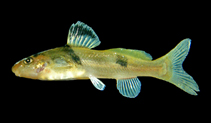| Family: |
Bagridae (Bagrid catfishes) |
| Max. size: |
12.8 cm TL (male/unsexed); max.weight: 6.5 g |
| Environment: |
demersal; freshwater |
| Distribution: |
Asia: Northern Malay Peninsula, with the southermost limit in the Perak and Terengganu drainages and northwards to the Tapi River drainage on the eastern slope, reaching northwards to the Tenasserim River drainage on the western slope of Bilaktaung Range in southern Myanmar. |
| Diagnosis: |
Dorsal spines (total): 1-1; Dorsal soft rays (total): 7-7; Anal spines: 4-5; Anal soft rays: 8-9. Distinguished from all other species of the genus Batasio, except Batasio merianiensis in having an adult coloration consisting of a dark oblique predorsal bar and a dark spot on the sides of the body below the middle of the adipose-fin base. Differs from Batasio merianiensis by having length of adipose-fin base 30.0-33.3% SL (vs. 22.2) and eye diameter 18.2-23.5% SL (vs. 25.9) (Ref. 74340). |
| Biology: |
Occurs in rivers and streams with moderate to swift current and a predominantly rocky bottom; less often in slow-flowing streams with a muddy substrate. Hides among stones or submerged vegetation during the day and comes out at night to feed (Ref. 44354). |
| IUCN Red List Status: |
Least Concern (LC); Date assessed: 13 May 2019 Ref. (130435)
|
| Threat to humans: |
harmless |
Source and more info: www.fishbase.org. For personal, classroom, and other internal use only. Not for publication.

